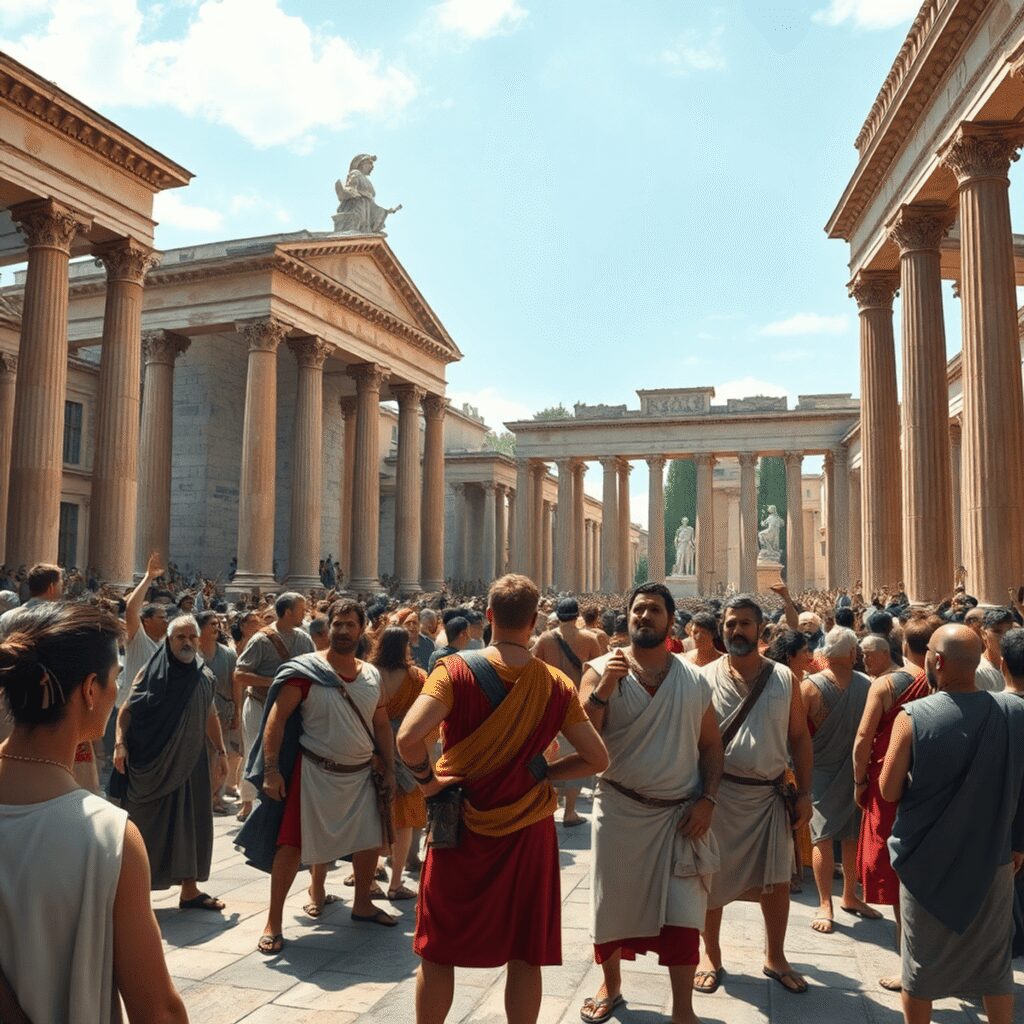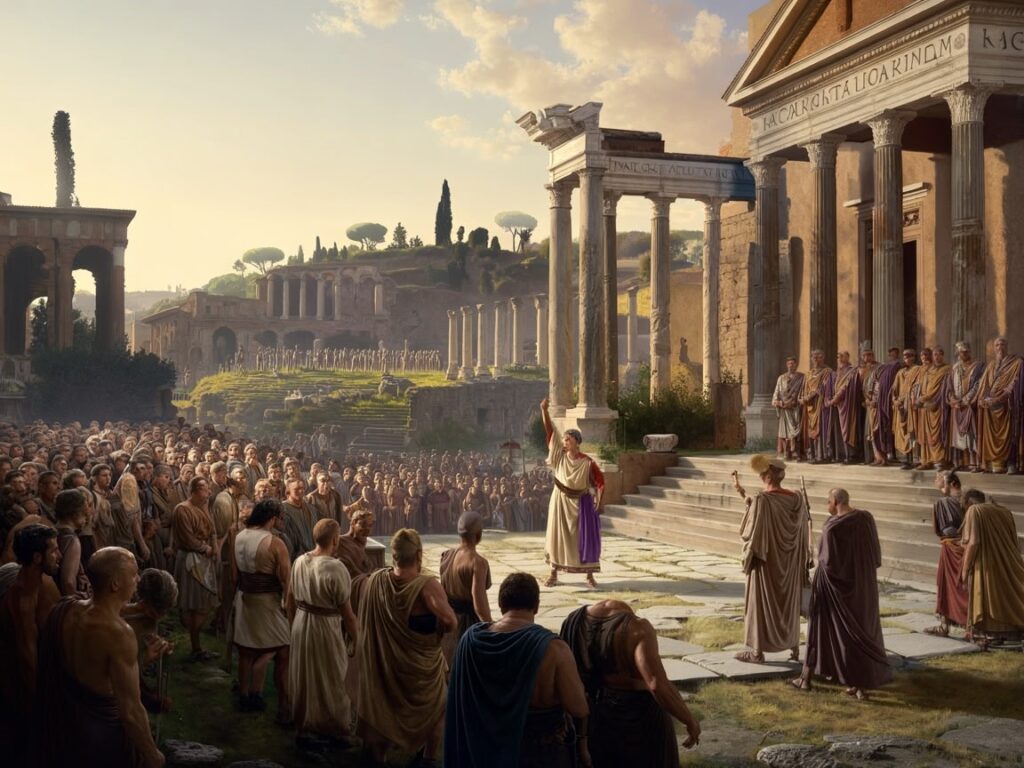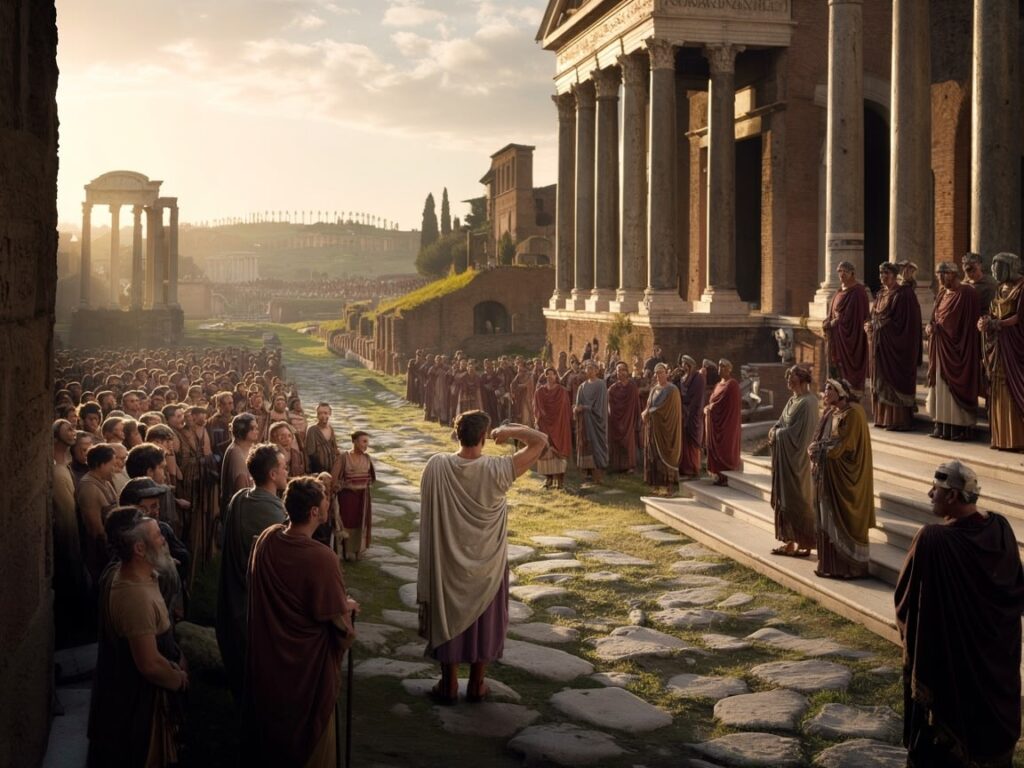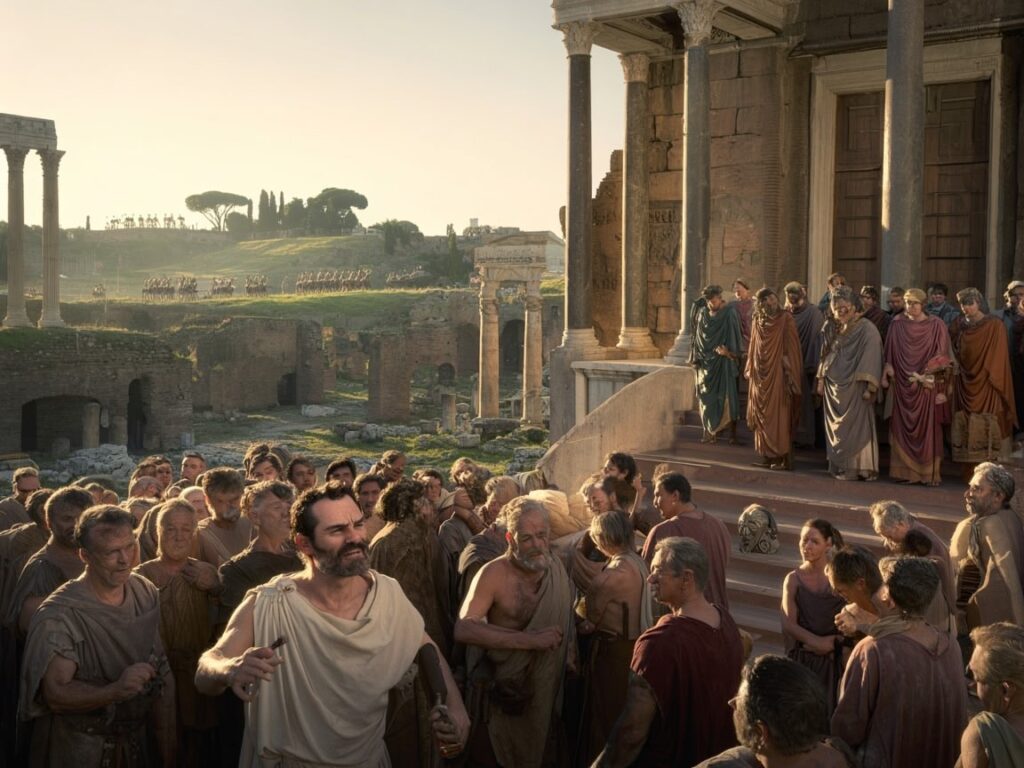The rise of plebeian politicians, a pivotal chapter in the history of the Roman Republic, represents a significant political transformation. These self-made men emerged from the common populace to challenge the long-standing aristocratic dominance held by patrician families, reshaping power dynamics and expanding the scope of governance.
Key events such as the Conflict of the Orders—a prolonged struggle between plebeians and patricians—highlight the tensions driving this shift. Landmark reforms like the Lex Licinia Sextia empowered plebeians by granting them access to high political offices, including the consulship, positions previously monopolized by patricians. Such legal changes ignited the rise of notable plebeian politicians who played critical roles in steering Roman politics.
This movement toward inclusion did more than redistribute political power; it fundamentally transformed Roman governance. It laid foundations for a society where political participation was no longer confined to hereditary privilege but opened to merit and ambition. The rise of plebeian politicians illustrates how determined individuals from modest beginnings can alter entrenched systems, fostering a more representative and resilient Republic.
Entertainment in Ancient Rome, such as gladiators, chariot races, and theaters, played a crucial role in society and had significant effects on social relationships and political authority. This spectacle not only served as a source of entertainment but also influenced the power structure in Rome.
The legacy of Ancient Rome remains a cornerstone of Western civilization. From its inception as a small city-state to its transformation into a vast empire, Rome’s influence is both profound and enduring. The impact of Roman culture, governance, and innovations can be seen in various aspects of modern society, which is explored in detail in this article on the legacy of ancient Rome.
Moreover, understanding the structure of power during the Roman Republic provides insight into how this complex political structure laid the foundation for modern democracies and established key principles of governance that resonate today.

Understanding the Roman Social Structure
The Roman class system initially divided society into two distinct groups: patricians and plebeians. Patricians were the aristocratic elite, holding exclusive rights to political offices, religious duties, and major landholdings. They enjoyed a lifestyle that was vastly different from that of the plebeians, who formed the majority of the population, consisting of farmers, artisans, and laborers. This blog post explores their daily activities, traditions, and ways of living.
Despite their numbers, plebeians faced significant political and social restrictions. They were excluded from holding high magistracies and were often barred from influential religious roles. The religious practices of the Romans were not merely a set of beliefs but a comprehensive system that intertwined with every aspect of their lives, influencing politics, culture, and social structures.
Land ownership played a crucial role in this social hierarchy. Patricians controlled large estates, which not only secured their wealth but also reinforced their political dominance. Plebeians, with limited land and resources, struggled to gain economic independence, which in turn restricted their participation in governance. The concentration of land and political power among patricians established a system where social mobility was nearly impossible.
Additionally, the legal status of Roman women added another layer to this complex social structure. The legal framework surrounding Roman women reflects a complex interplay of rights and restrictions that significantly influenced gender dynamics in ancient Rome. Their citizenship was intrinsically linked to their relationships with men, such as fathers or husbands.
Overall, this persistent tension between classes highlighted the rigid nature of the Roman social hierarchy. The architectural landscape during this period also reflected these societal divisions. The Romans were not merely builders; they were innovators who transformed the architectural landscape of their time with masterpieces of ancient engineering, serving as a testament to their power and cultural identity.
The Struggle for Plebeian Rights: Conflict of the Orders
The Conflict of the Orders was a long-lasting political struggle between the patricians and plebeians that significantly influenced early Roman history. This tension, which lasted for centuries, stemmed from deep social and political inequalities, with plebeians fighting for acknowledgment and rights in a system controlled by patrician elites.
The First Plebeian Secession
A crucial turning point in this conflict occurred during the first plebeian secession in 494 BC. During this event, plebeian citizens collectively withdrew from the city in protest, refusing to serve in the army or work, effectively bringing Rome’s daily activities to a standstill. This act of civil disobedience compelled the patricians to engage in negotiations, resulting in the establishment of the Tribune of the Plebs, a new office created to safeguard plebeian interests.
Key Issues of Plebeian Demands
Plebian demands revolved around several important matters:
- Political inclusion: Plebeians sought access to magistracies and the ability to influence laws.
- Legal equality: They aimed to protect themselves from patrician abuses through written laws.
- Economic relief: Debt bondage and land ownership restrictions disproportionately impacted plebeians.
This political struggle was not merely about power but rather about being acknowledged as equals within the Roman state. The Conflict of the Orders laid the groundwork for a series of reforms that gradually dismantled patrician exclusivity, empowering plebeians to actively participate in governance and shape Rome’s future.

Empowering the Common People: Key Political Reforms
The Tribune of the Plebs became an important institution after the first plebeian secession in 494 BC. Tribunes had significant power, including the ability to veto (intercessio) decisions made by magistrates or the Senate that could harm plebeian interests. This role was crucial for protecting plebeians from patrician abuses and gave them a formal voice in Roman politics.
Several important laws further broke down barriers between classes:
1. Lex Canuleia (445 BC)
This law legalized marriage between patricians and plebeians, breaking down social divisions and enabling alliances across class lines. It laid the social groundwork for plebeians to integrate more fully into Rome’s power structure.
2. Lex Licinia Sextia (367 BC)
This law marked a major breakthrough by granting plebeians access to the consulship, Rome’s highest elected office. It required that at least one of the two consuls be plebeian, ending the patrician monopoly on executive power and opening paths for plebeians to influence governance directly.
3. Lex Hortensia (287 BC)
This law empowered the Plebeian Council by making its decisions (plebiscites) binding on all Romans without Senate approval. It significantly increased the political weight of plebeian assemblies and reduced patrician dominance over legislation.
These reforms created a political environment where plebeians could rise above their traditional social limitations. The rise of plebeian politicians—self-made individuals who took advantage of these new rights—reshaped Rome’s aristocracy and governance, paving the way for a more inclusive Republic.
The Rise of Plebeian Politicians: From Commoners to Nobiles
The political reforms that empowered plebeians did more than grant rights—they created a pathway for self-made men to ascend Rome’s political hierarchy. Ambitious plebeians, once excluded from the highest offices, began to secure key magistracies and influence in the Republic. This shift eroded the exclusive hold of the patrician aristocracy, known for their luxury and power, and gave rise to a new elite class known as the nobiles, which blended both patrician and plebeian lineages.
The nobiles class represented a transformation in Roman politics, where political inclusion was no longer determined solely by birth but by achievement and family legacy. Membership in this elite was often secured by holding prominent offices such as the consulship, a position plebeians gained access to after the Lex Licinia Sextia.
Notable plebeian politicians
Notable plebeian politicians exemplify this rise:
- Gaius Licinius Stolo: Instrumental in passing the Lex Licinia Sextia, he championed plebeian rights and helped break patrician monopolies.
- Lucius Sextius Lateranus: The first plebeian consul, his election marked a turning point in Roman political equality.
- Marcus Fulvius Flaccus: Known for his oratory and reformist agenda, he further elevated plebeian presence in governance.
These figures embodied the concept of self-made men, leveraging political reforms to challenge aristocratic dominance and reshape Rome’s leadership landscape. Their successes set a precedent for political mobility based on merit and service, redefining what it meant to belong to Rome’s ruling class.
The complexities of this period
However, this period of political transformation was not without its complexities. The rise of Stoicism during this time influenced many of these politicians’ thoughts and actions. Stoicism emphasized virtue and reason as paths to achieving human flourishing, ideals that resonated with these self-made men.
Moreover, while plebeians were making strides in politics, notable figures like Scipio Africanus were changing the course of history through military achievements. Scipio’s victory over Hannibal in the Second Punic War established Rome’s dominance over Carthage, further solidifying its status as a powerful entity.
This era also marked the beginning of the Rise and Fall of the Roman Empire, a period that spanned over a millennium and left an indelible mark on world history. The empire was not merely a political entity; it was a tapestry woven from diverse cultures, languages, and traditions.
As these changes unfolded politically and militarily, they were paralleled by remarkable developments in art and culture during ancient Rome. This period is marked by artistic expressions heavily influenced by earlier Greek and Etruscan traditions.

Transforming Roman Governance and Society Through Inclusivity
The inclusion of plebeians in Roman politics led to a more balanced governance system. Their increased participation introduced new perspectives that challenged the patrician monopoly on power. This shift resulted in notable improvements in legislative fairness—laws began reflecting the interests of a broader segment of society rather than serving a narrow elite.
Key impacts include:
- Enhanced accountability: Plebeian magistrates and tribunes could hold patrician officials responsible, using veto power and public assemblies to check abuses.
- Broader representation: With plebeians able to hold offices like the consulship and participate fully in the Centuriate and Tribal Assemblies, laws were debated and enacted with input from diverse social groups.
- Legal reforms: The enactment of laws such as the Lex Hortensia made plebiscites binding on all Romans, reducing Senate dominance and elevating the Plebeian Council’s role in lawmaking.
This expansion of political rights fostered democratic processes within the Republic by encouraging transparency and citizen involvement. It helped establish a legal framework where decisions required consensus beyond aristocratic circles, promoting social cohesion. Notably, this transformation in governance not only balanced interests between classes but also strengthened Rome’s institutional stability by embedding inclusivity at its core.
Furthermore, the establishment of legal codes such as the Twelve Tables, which were created between 451-450 BCE, marked a significant milestone in the development of Roman law. These laws were the first attempt to codify the complex legal practices of ancient Rome. This foundation supported Rome’s future challenges as it grew into a complex republic demanding adaptable and fair political structures.
Additionally, it’s important to acknowledge the profound impact of the Corpus Juris Civilis, commissioned by Emperor Justinian I in the 6th century AD. This comprehensive codification not only preserved ancient Roman legal principles but also adapted them to meet contemporary societal needs, marking a crucial turning point in the development of legal systems, especially in Europe.
In summary, while gladiators were often viewed merely as entertainers or victims within this evolving societal structure (The Gladiators: Heroes or Victims of Roman Entertainment), their existence also reflects the complexities and contradictions inherent in Roman society. The birth of this republic from a monarchical rule (The Birth of the Roman Republic: From Monarchy to a New Political System) marked a pivotal moment in history that continues to influence modern political structures.
Beyond Politics: The Broader Impact on Rome’s Expansion and Institutions
The rise of plebeian politicians not only reshaped Rome’s internal political landscape but also had profound implications for Roman expansion and the evolution of republican institutions. Empowered plebeians played active roles in military leadership and administrative duties, which were crucial during Rome’s aggressive territorial campaigns throughout Italy. Their participation helped to diversify the leadership pool, bringing fresh perspectives and energies that supported sustained military successes.
Key aspects of this broader impact include:
- Military Leadership and Expansion: Plebeian commanders led legions in significant battles, contributing to the conquest of neighboring territories. Their rise broke traditional patrician dominance in military command, enabling a merit-based approach that enhanced Rome’s effectiveness as a growing power. The Roman Army, a symbol of military power, played a crucial role in the growth and upkeep of the Roman Empire. Its structure, strategies, and operational effectiveness were key in achieving victories across large areas.
- Administrative Adaptability: Inclusive reforms empowered plebeian magistrates who introduced practical governance measures to manage newly acquired lands. This adaptability was essential for integrating diverse populations and maintaining order across expanding borders. The rise of agriculture during this period was a crucial driver of Rome’s economic growth, extending beyond mere food production to become a significant sector in Roman economic growth.
- Institutional Stability: By broadening political participation, reforms fostered a more balanced distribution of power within the Republic. This balance prevented extreme factionalism and strengthened republican institutions, making them resilient enough to govern an empire-in-the-making.
- Political Evolution: The emergence of a mixed elite class, or nobiles, composed of both patricians and plebeians, reflected a new political reality where ability and service increasingly determined influence. This evolution was central to Rome’s capacity to sustain complex governance structures alongside rapid territorial growth.
The story of Rome is not merely one of conquest and expansion; it is also a tale of innovation, culture, and governance that has left an indelible mark on the world. The Rise of the Plebeian Politicians: Rome’s Self-Made Men proved instrumental beyond mere political reforms—they were key actors in transforming Rome into a formidable republic capable of managing both internal challenges and external ambitions.

Lessons from Rome’s Self-Made Leaders for Modern Governance Systems
The legacy of plebeian politicians offers valuable insights into the evolution of governance and leadership. Rome’s experience with inclusive political reforms demonstrates how opening political pathways to individuals from diverse social backgrounds can:
- Enhance social mobility, allowing talented individuals to rise based on merit rather than birthright.
- Strengthen governance by incorporating broader perspectives and interests.
- Promote stability through more representative institutions that reflect the population’s diversity.
The Roman Republic’s transformation, driven by self-made leadership, reveals how political inclusion fosters innovation and resilience in government structures. The Rise of the Plebeian Politicians: Rome’s Self-Made Men illustrates that removing systemic barriers to leadership creates a dynamic political environment—one capable of adapting to challenges and expanding its influence.
Moreover, the principles of Roman Law, which originated in ancient Rome, have played a crucial role in shaping modern legal systems. Understanding this legacy is essential for grasping the foundations of contemporary laws.
Additionally, the significance of Roman engineering lies in its capacity to connect far-flung regions, ensuring effective governance and cultural exchange. Their techniques had a lasting impact on future generations, serving as a foundation for contemporary infrastructure systems.
Lastly, it’s interesting to note the influence of Roman mythology on modern culture. The Romans adapted much from Greek myths to reflect their own societal norms and political aspirations.
Modern societies can apply these lessons by designing political systems that actively encourage participation from all segments of society, ensuring leadership reflects the true complexity of its citizenry.
FAQs (Frequently Asked Questions)
What led to the rise of plebeian politicians in ancient Rome?
The rise of plebeian politicians in ancient Rome was driven by the Conflict of the Orders, a prolonged political struggle where plebeians challenged patrician dominance. Key reforms like the Lex Licinia Sextia empowered plebeians, enabling them to access political offices and transform Roman governance.
How did the Roman social structure impact plebeians before their political empowerment?
In early Rome, society was divided between patricians and plebeians. Patricians held most political power and land ownership, while plebeians faced significant social and political restrictions, limiting their participation in governance and maintaining aristocratic dominance.
What was the Conflict of the Orders and why was it significant?
The Conflict of the Orders was a centuries-long struggle between patricians and plebeians for political equality. It included events like the first plebeian secession in 494 BC, highlighting plebeians’ demands for inclusion and setting the stage for transformative reforms in Roman politics.
Which key political reforms empowered plebeians in the Roman Republic?
Important reforms included the creation of the Tribune of the Plebs with veto power to protect plebeian interests, Lex Licinia Sextia allowing plebeians to hold consulship, Lex Canuleia legalizing inter-class marriages, and Lex Hortensia enabling Plebeian Council decisions to be binding without Senate approval.
How did plebeian politicians transition from commoners to members of the nobiles class?
Political reforms facilitated social mobility for ambitious plebeians who rose through political ranks to form the nobiles class—a new elite that combined both patrician and plebeian families. Notable plebeian politicians emerged as influential leaders shaping Roman politics during this era.
What broader impacts did increased plebeian political participation have on Rome?
Greater plebeian involvement improved legislative fairness, accountability, and democratic processes within Roman governance. This inclusivity supported Rome’s territorial expansion across Italy and established stable republican institutions capable of managing an expanding empire effectively.

